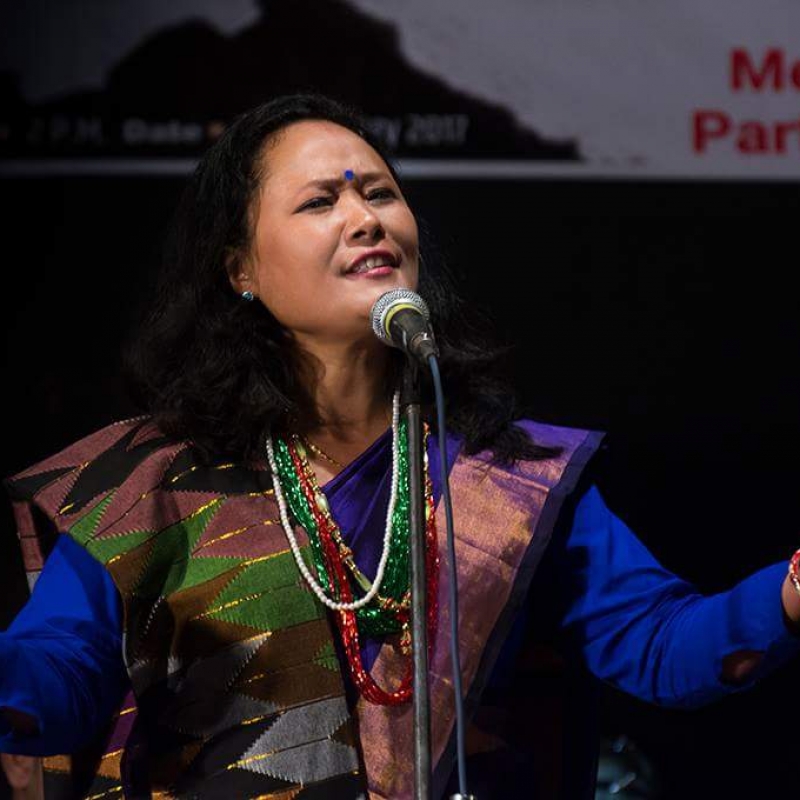The performance poetry form avisangi is primarily found in the Darjeeling Hills, West Bengal. What might be regarded as a genre in its own right now, emerged out of the efforts of its creator, Pavitra Lama (born in 1976 in Kalchini, Dooars, West Bengal), to make poetry more popular. Lama, best known for her books of poems Sabhyataka Pendulamharu (2016) and Ma Deh Raato Ranginchu (2019), is an Indian Nepali poet, currently posted in Malda Collectorate, West Bengal, as a deputy magistrate/collector. She began to formally perform in 2015 after winning the Dhamari (a platform conceptualised by Nepali Sahitya Sansthan, Siliguri, in 2015, and is similar in essence to slam poetry competitions) in the same year, even though she had been writing since she was four. Lama claims that the term avisangi kavita (poetry) was coined by the Indian Nepali critic and poet Jai ‘Cactus’ Gurung after closely watching and analysing the features of her performances which he realised were different from slam poetry or performance poetry of the West.
The term avisangi is a portmanteau that derives from the terms abhinaya (acting) and sangeet (music) which are extremely significant to understand performative arts in the Indian classical tradition. However, Lama’s avisangi performances not only revisit but also tend to extend the connotations that abhinaya and sangeet have in the Indian classical tradition. Simply put, the term avisangi means a mode of representing a poem verbatim through acting and music where both aspects share equal prominence and must be given equal consideration.
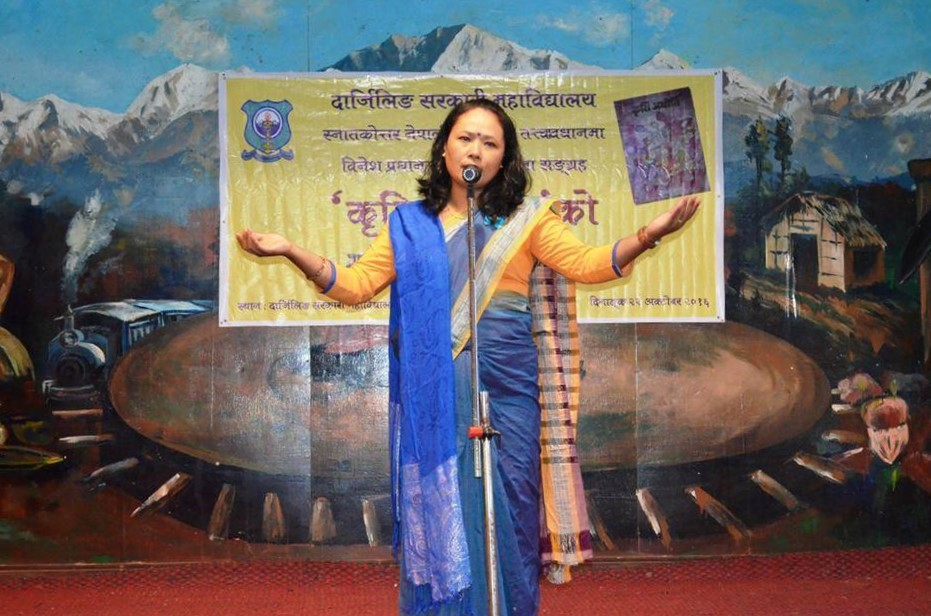
Since its inception, avisangi has been confused with performance poetry of the West by the larger Indian populace outside the Darjeeling Hills. However, the very essence of avisangi performances distances their composers’ and performers’ engagement from the conventions of performance poetry of the West. Unlike performance poetry, the performer of avisangi kavita not only composes all the poems to be performed but must also learn the poem by heart before performing, only then can they establish a direct connection with the poem that they are performing, the character they are reliving, and the audience. Thus, avisangi performances are marked by a curious overlap between the roles of the poet or the composer, the performer, the narrator and the characters.
According to Indian Nepali litterateurs and critics, many Indian Nepali poets began to employ the performative mode to reinstate people’s love for poetry, a genre which they believe was immensely neglected and had slowly begun to lose its significance. It is because of this very reason that the Indian Nepali culture witnessed a sudden surge in performance poetry in the Darjeeling Hills at the turn of the twenty-first century, especially since its second decade. The primary motivator behind Lama’s avisangi is the belief that poetry mixed with performance will not only be successful in bringing poetry back into the mainstream, but in the process will also draw people’s attention towards issues that are often overlooked both within and outside the community. Thus, avisangi performances have been successful in transporting the text from the domain of the written to the spoken and have truly bridged the gap between the two domains.
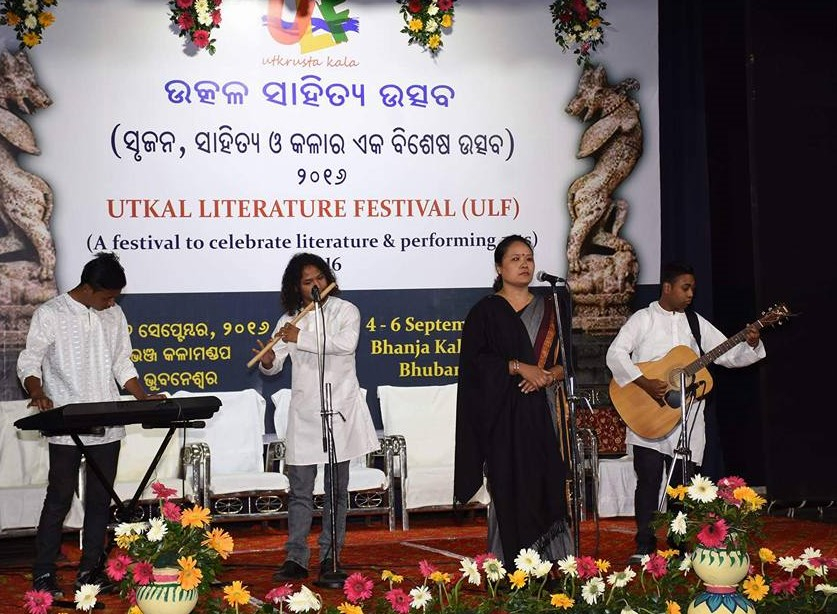
Avisangi performances act as major links between that section of the Indian Nepali population which is far removed from written literature and other printed materials such as newspapers, magazines, etc., and the rest of the country. Even today, only a small segment of the Indian Nepali population can read and write and thus associate more with oral or visual literary modes and other forms of cultural productions such as songs, theatrical performances, etc. Therefore, the poems that form the core of avisangi performances take up issues that are serious in nature such as those of identity, women, children, tea garden workers and people involved in other forms of manual labour, as well as sociopolitical issues such as the Gorkhaland movement, and portray them in an engaging and interactive manner. The key feature of avisangi kavita is its desire to reach out to every section of the society irrespective of age, class, caste, gender, religion, etc.
Though at a nascent stage of academic engagement, the multifaceted quality of avisangi performances have attracted the attention of literary critics such as Jai ‘Cactus’ Gurung and Kabir Basnet (assistant professor at the Department of Nepali, Darjeeling Government College, Darjeeling, West Bengal, who is married to Pavitra Lama). Gurung and Basnet have gradually attempted to theorise avisangi kavita based on the Natyashastra (classical Indian text on the art of performance attributed to Bharata Muni). According to Basnet, ‘the reaction of the audience during and after the performances have also been a major factor in the process of theorising the genre.’[1]
Elements of an Avisangi Performance
Kavita
Since at every point, an avisangi performance must aim to minimise the gap between the poet-performer and the audience as well as between the poem and its performance, its narrative must bear a resemblance to the plot of a story. The performance can either have a definite beginning, middle and end or begin in medias res and is usually within a duration of seven to 10 minutes, neither too long not too short. Two of Lama’s most performed poems, ‘Marsaang’ and ‘Asaari’, consist of 19 and 16 stanzas, respectively, and each of these stanzas contains two to 16 lines; another regularly performed poem of hers, ‘Harkamaya’ consists of 12 stanzas containing four to 15 lines each.
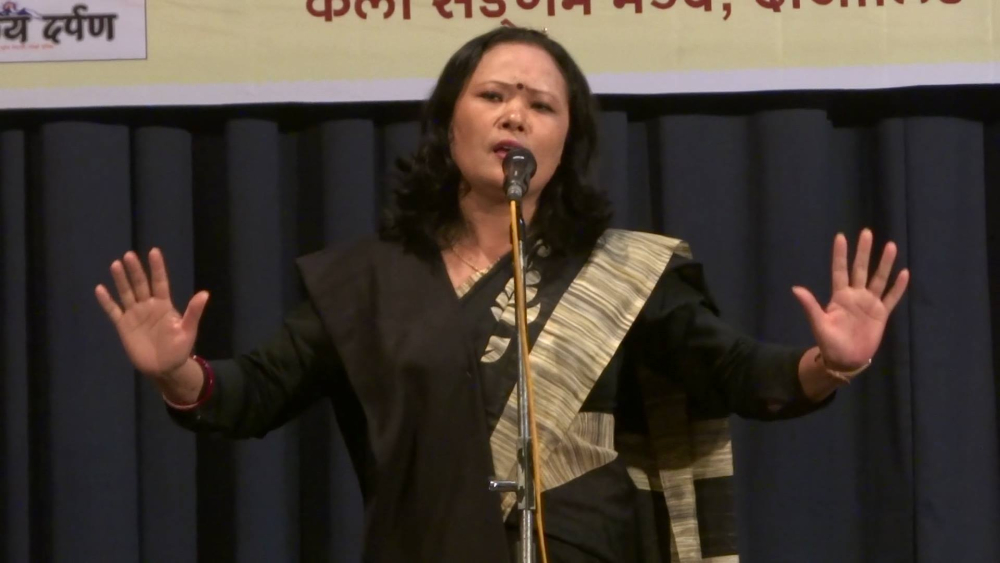
Abhinaya
Abhinaya is a very significant element of live theatrical performances. In avisangi kavita performances, abhinaya is used to stress upon certain elements, lines, stanzas and even themes in the poems that are performed. Avisangi kavita tries to maintain a balance between the written poems and the performances based on them: the performance should remain true to the written poem but at the same time be able to stand on its own, such that its elements can be analysed independently.
The components of abhinaya range from vocal projection and clarity of speech to physical expressivity of the poet-performer. Since all these elements come together in an avisangi kavita performance, to ensure a good performance, the poet-performer must see to the fact that the audience becomes so involved with the poem and its performance that it becomes difficult for them to differentiate between voices of the poet, performer, narrator and character. Though disparate with their individual identities, these voices often overlap in Lama’s performances. This is primarily because they are all voices of women, who irrespective of their different backgrounds have realised that their experiences are universal and must be dealt with collectively.
Thus, every poem performed is learnt by heart such that maximum abhinaya is possible. Consulting a written or printed text during the performance, unless absolutely necessary, runs the risk of undermining the effect that the performance is intended to have on the audience.
According to Lama, ‘the other important aspects of abhinaya—uniform intonation, correct pronunciation, clear diction, and an uninterrupted flow of both speech and music—are the hallmarks of a successful avisangi performance.’[2] Thus, every single avisangi kavita performance goes through multiple rounds of corrections, modifications and alterations.
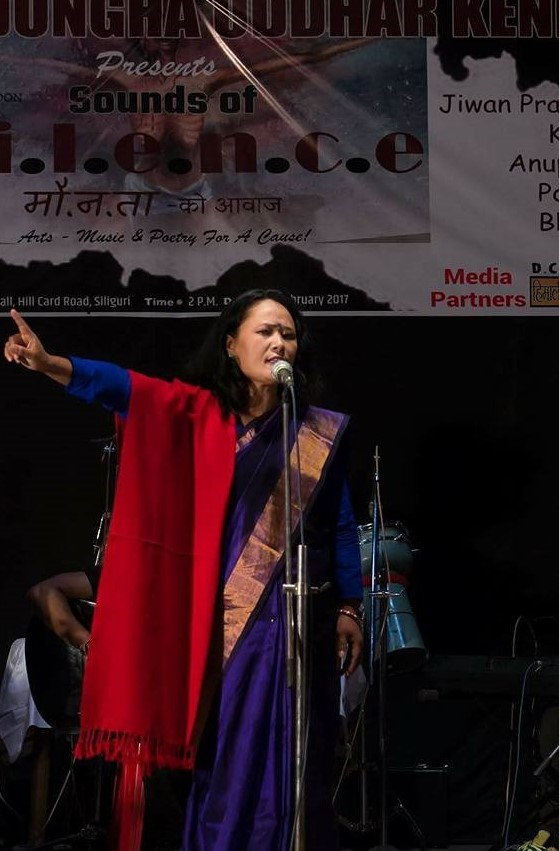
Sangeet
Kavita and sangeet generally complement each other in the course of an avisangi kavita performance. Music fills the gaps between the various stanzas of a poem as well as between different poems during a longer performance; this helps in retaining the attention of the audience and to ensure that the audience is not distracted. Since music happens to be an integral part of the performance, both the composition and the selection of musical instruments are equally important and depends on the primary theme, the tone, and the rasa[3] of the poem. The poet-performer synchronises their recitation with the beats of the music through multiple rehearsals, thus a harmonised avisangi performance also depends on the two parties being able to respond to each other’s cues.
Lama has performed to both live music as well as pre-recorded music which usually plays in the background and has had to adjust differently to the two circumstances. In the case of pre-recorded music, there is no scope for improvisation as there is no control over the music; on the other hand, live bands provide ample opportunity for improvisation and each of the musicians gets their own time to play their instrument, mostly flute, violin, guitar, and synthesiser. An avisangi performance often begins with one instrument, while the other musicians chime in between stanzas or poems during the performance. Lama often sings portions from poems instead of just reciting them for added effect.
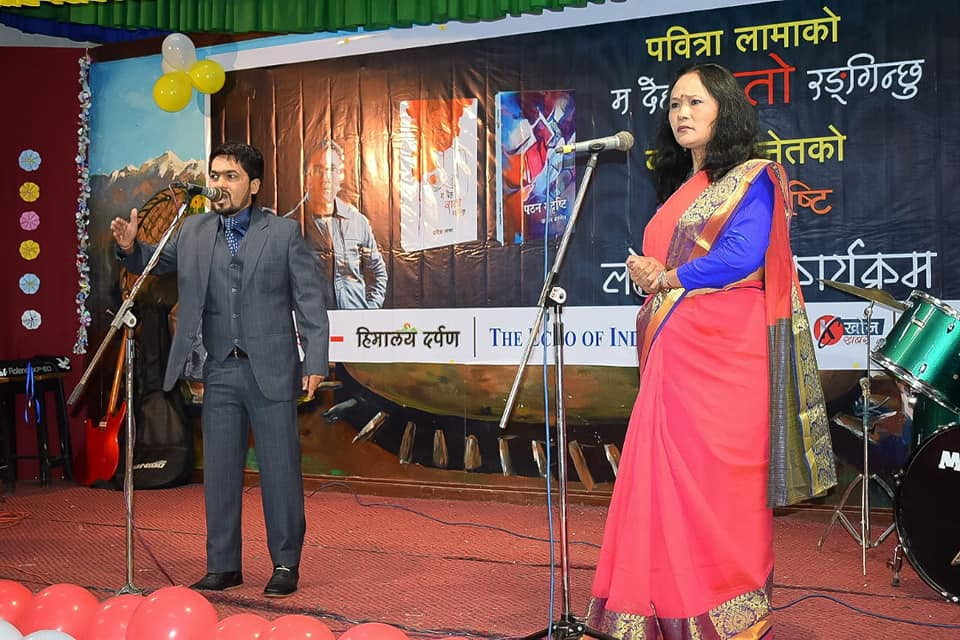
Costume
Even though Lama’s avisangi performances have never witnessed elaborate costumes, the poet believes that it is an important signifier and thus germane to the performances as it contributes to the kind of effect the performance has on its audience. During her performances, she often changes the shawl that she is wearing to differentiate one poem from another; till date, the most widely used colours have been black and red. The black shawl, which symbolises silent protest against major societal evils such as child labour and exploitation of women, and stands for identity crises, has been used in avisangi performances of poems such as ‘Asaari’ and ‘Chourastaa’. The red shawl which represents the domestic ties of women has been used in the avisangi performance of the poem, ‘Yashodaharu Parkhibaschhan Krishnalai’ where the poet-performer speaks as Yashoda, foster-mother of Lord Krishna.
Audience as the interpreter
In avisangi performances, like in most other live theatrical performances or recitals, the audience acts as the primary receiver. It is essential to take audience reactions into account as audiences are the most important aspect of these performances along with the poet-performers themselves. The audience may or may not respond to a particular performance as intended or derive the same meaning out of a performance as is expected of them by the performer, but they engage with their own interpretations which not only makes them the creators of new meaning but also the bearers of this new meaning, thus, acting as bridges between the performer and the rest of the Indian Nepali community. Audience reaction depends on various factors, all of which together formulate their worldview, which include class, caste or tribe, gender, educational background, the kind of work they do, language (as Nepali is only one of the many languages spoken the Indian Nepali community, as tribes such Tamangs, Magars, Gurungs, Lepchas have their own languages as often their own scripts), the kind of place they live in (since the Darjeeling Hills comprises a handful of big towns along with many smaller towns and villages), etc.
Since the audience of avisangi performances cut across the strata of age, class, caste, gender, the poet-performer chooses poems that are couched in a simple language. The poems normally do not include a lot of technical or complicated words, so that the performances remain lucid. In avisangi performances, a lucid poem is considered a good poem because Indian Nepali poets believe that a poem that connects to the audience at multiple levels ensures a good performance. The connection with the audience can be achieved by composing poems that deal with subjects that concern the audience. Lama takes up issues that are not merely of importance to the Indian Nepali community but are of universal concern; majority of her poems try to throw light on the fact that our society is inherently patriarchal and women irrespective of their class and caste are the victims. Additionally, women in the Indian Nepali community are doubly marginalised, not only for being women but for being women in a community that is already marginalised in India. Lama’s poems such as ‘Harkamaya’ and ‘Mahavinishkramanpachhi’ shed light on the experiences of women, their repressed existence, and their need to bring about a collective revolution. Her poem ‘Chowrasta’, born during the last phase of the Gorkhaland agitation of 2017, and intended to be performed to a gathering on the streets, talk about the overarching identity crisis that the Indian Nepali community suffers from.
A good poem as defined by avisangi performers attempts to interact with the audience throughout the course of the performance. In a live performance, the performer is said to be constantly feeding off the audience’s energy in a sort of cyclical exchange: only when the audience reacts in a certain way can the performer go about performing in a particular way, so as to be able to lead the audience to forge an immediate emotional connection with the performance. Since the primary aim of the genre is to make people listen to poems as opposed to reading them, avisangi performances attempt to communicate a sentiment, an emotion or an issue in such a way that it reaches every individual, irrespective of their language and sociocultural background.
The audience has been instrumental in making avisangi kavita a popular genre across the Darjeeling Hills, which has resulted in Lama travelling to and performing at various literary meets and festivals in eastern India, including Sikkim and Orissa and various events across West Bengal.
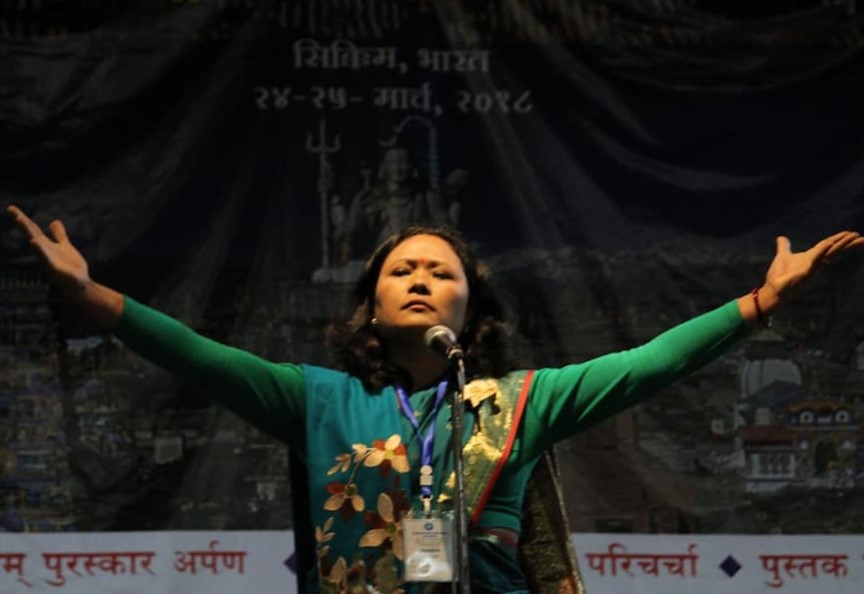
Challenges of an anomalous poetic form
Both Lama and the genre of avisangi kavita have incurred their fair share of criticism in the last decade. On the one hand, she is often called biased as the primary themes of her poems relate to issues concerning women, transgender people, and refugees; on the other hand, performance poetry is not given due credit in the Indian Nepali scene as it is believed that the poem or the written word which should be of primary importance is overshadowed by the aspects of abhinaya and sangeetduring the course of a performance. According to Dr Kabita Lama, a literary critic and associate professor at the Department of Nepali, Sikkim University, Gangtok, Sikkim, many traditional Indian Nepali poets tend to prefer the permanence of the written word over the transient and ephemeral quality of the poetry performances.[4] The volatile political scenario in the Darjeeling Hills and the ongoing Gorkhaland movement often hampers literary inventions and innovations. Further, newly emerging genres like avisangi kavita are very region and language specific and even though, they are universal in their approach, they cannot help but be limited in their reach.
Notes
[1] Kabir Basnet and Pavitra Lama, in conversation with the author, Darjeeling, April 5, 2018.
[2] Pavitra Lama, in conversation with the author, Darjeeling, October 1, 2019.
[3] Rasa according to Bharata’s Naṭyashastra means ‘juice’, ‘essence’ or ‘taste’. There are eight rasa-s according to the Naṭyashastra.
[4] Kabita Lama, in conversation with the author, Kolkata, June 14, 2018.
Bibliography
Blood, Melanie. ‘Audience, Part I’. Geneseo.edu. 2015. Accessed February 5, 2020. https://www.geneseo.edu/~blood/Aud1.html.
Chanda, Ipshita, ed. Literature and Other Arts. New Delhi: Sahitya Akademi, 2018.
Dasgupta, Subha Chakraborty, ed. Literary Studies in India: Genology. Kolkata: DSA, Comparative Literature, Jadavpur University, 2004.
Hutt, Michael James. Himalayan Voices: An Introduction to Modern Nepali Literature. Delhi: Motilal Banarsidass, 2007.
———. Modern Literary Nepali: An Introductory Reader. Delhi: Oxford UP, 1997.
Lama, Pavitra. Ma Deh Raato Ranginchu. Jalpaiguri: Sambodhan Publication, 2019.
———. Sabhyataka Peṇdulamharu. Mirik: Bheema, 2016.
Pradhan, Kumar. A History of Nepali Literature. New Delhi: Sahitya Akademi, 1984.
